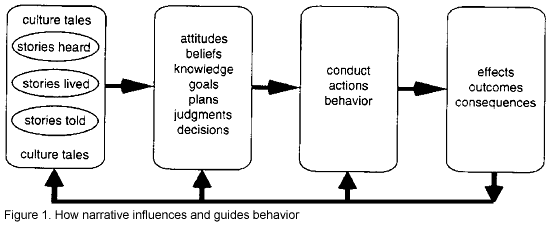There are two ways of knowing and understanding the world, through narrative (stories) and through formal logical paradigms. Narrative thinking involves knowing through stories heard, stories lived, and stories told. Persons' goals, plans, beliefs, attitudes, and knowledge are influenced by their culture tales (stories). These narratives also direct persons' judgments, decisions, conduct, actions, and behaviors (see Figure 1). Stories are universal and powerful guides for living and understanding of our own and others' conduct.

The
theory of narrative thinking has been used to construct problem
solving exercises to influence knowledge, attitudes, and conduct
to prevent injury events for specific jobs or tasks. The persons
who work the simulated problems read (or view or enact) a
developing story with a plot, characters, goals, obstacles,
and predicaments. The persons make decisions that involve
recognizing hazards and selecting behaviors and strategies
to lessen the hazards and to prevent injury events. The exercises
target high-frequency, high-severity injury events based on
injury surveillance data and actual cases. The narrative exercises
are not case studies, but dramatic and unfolding stories with
which the participant interacts as an observer or protagonist.
Over 400,000 copies of 65 narrative-based simulation exercises
have been used with mining industry workers in the U.S. The
University of Kentucky, Southeast Center for Agricultural
Health and Injury Prevention is currently developing narrative-based
problem-solving exercises for farm youth and farm families
to influence thinking, feeling, and conduct about specific
chores and tasks whose performance often results in near or
actual injury events. The underlying theory, design methods,
and effectiveness of narrative-based interventions are presented.
A short interactive simulation exercise about a 14-year-old
boy performing a difficult, dangerous chore involving a tractor
and a bush hog mower is provided. Reference citations are
included.
This research abstract was extracted from a portion of the proceedings of "Agricultural Safety and Health: Detection, Prevention and Intervention," a conference presented by the Ohio State University and the Ohio Department of Health, sponsored by the Centers for Disease Control/National Institute for Occupational Safety and Health.
The authors noted above are from: H.P. Cole, R.H. McKnight and L.R. Piercy, University of Kentucky, Lexington, KY.
Disclaimer and Reproduction Information: Information in NASD does not represent NIOSH policy. Information included in NASD appears by permission of the author and/or copyright holder. More